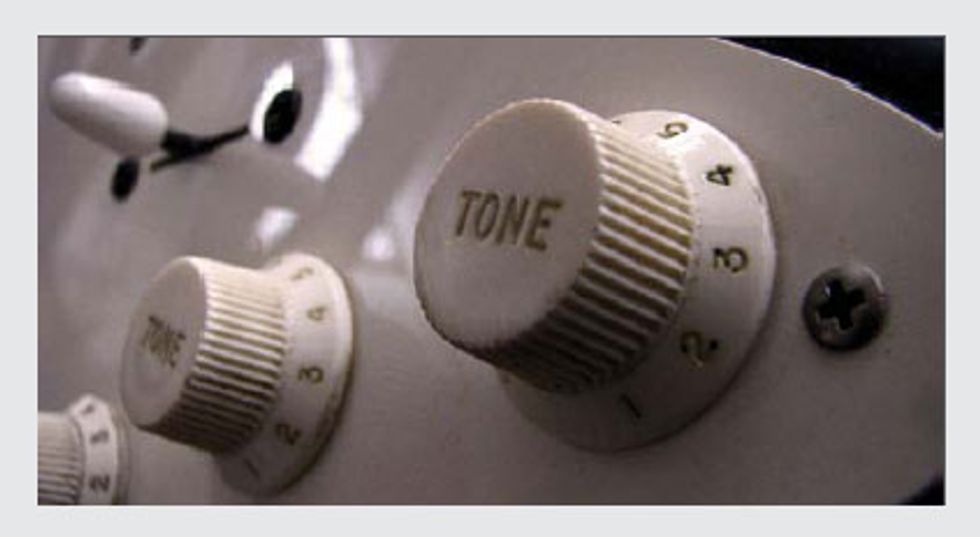Our love affair with effects
and aftermarket mods has
raged on unabated for decades
now, with no end in sight.
Guitarists love widgets and
constantly tinker with them to
tweak sounds and, in some cases,
to forestall actual practicing. I’ve
written in the past of my relative
abstention from pedals for subtle
tone modification, preferring to
stick mainly to the big guns of
sound processing, like the wah
pedal. But my weapon of choice
for on-the-fly tone manipulation
is the guitar’s volume knob. As an
old-school minimalist, I always
figured that my instrument’s
volume control was worth at least
three distortion and boost pedals—
and it’s easier to carry, too.
Truth is, the guitars that I’ve
designed over the years have featured
volume potentiometers that
reflected this philosophy, with
a semi-logarithmic taper that
presents a rapid increase right at
the end of the control’s rotation.
This makes for a kind of switch
effect that allows the player to
control amplifier distortion easily
with the guitar itself. By setting
a good, crunchy rhythm tone
with the guitar set at about 8, the
quick jump up to 10 would dial
in just the right amount of drive
for most lead work. Turning
down to about 6 could produce
even cleaner tones, if needed.
With a judicious matching of
pickup and pot values, you can
achieve an optimal balance. I’d
even built some little test boxes
that allowed me to juggle all the
values, including the tone cap, by
flipping a series of switches outside
the guitar. It’s not a unique
idea, I imagine, but it is a very
useful tool.

So imagine my surprise (and embarrassment) when after three-plus decades of playing professionally, I discovered the tone control. Sure, I’d used it to achieve “woman tone” or hollow, Michael Schenker-esque lead tones, but in those cases the tone control was backed all the way down and amp distortion was complicit. But what I’m talking about in this column is Keith Richards clang, Joe Perry punch, and Don Rich-style clean-Telecaster territory.
My epiphany happened innocently enough when someone left one of my Teles on its stand with the tone control backed off slightly. I picked it up, plugged it in, and started playing. Thunderstruck, I started experimenting with the zeal of a child with a new toy on Christmas morning. Suddenly, all those classic tones that seemed just out of reach before were right there in my hands. It was a good day. I also found it applicable to the bass. My ’64 P bass warmed up and sounded even woodier with the tone down a little and the volume control backed off. In both cases, it wasn’t just an absence of treble, but the way these settings affected how the amp responded to my touch.
Certainly, the sonic shadings available from the interplay between volume and tone aren’t a secret, but just how prevalent is this technique? To get some perspective on the subject, I risked further humiliation and asked a few players and producers how they viewed the lowly tone control. Interestingly, Brian Henneman of the Bottle Rockets related a story similar to mine. “In the past, I never touched a tone control,” he confided. “It took years for me to find its usefulness. It can do great things for the guitar’s audibility—where you feel like you’re being swallowed by your surroundings.” If you’ve ever sampled Brian’s work, you will appreciate the breadth of this statement. “The tone control can really help a Tele hold its ground in a band situation,” Henneman continued. “Just roll it back until your guitar jumps out of the mix—works great.”
Of course, the world of guitar wouldn’t be as interesting if the exact opposite weren’t true as well. “Recently, I converted one of my Telecasters to a single-pickup Esquire,” explained producer Eric Ambel. “I realized I was going to miss the Esquire position that bypasses the tone control, so I put a pull-pot in the tone-knob position. When it’s down, the guitar’s signal skips the tone control and goes straight to the amp.” When I asked him to describe the result, he answered simply, “I get a bigger sound when the tone control is out of the circuit.” Eric did, however, confirm my discovery of the P-bass tone control. “In the studio,” he told me, “I almost always have bass players roll off all the instrument’s treble. I almost always prefer a bass with flatwound strings, too.”
Of course, this made me rethink the specifications for my own guitars. It looks like my switching console is going to be getting overtime pay.
Bruce Kulick (Kiss, Grand Funk Railroad)
“Though many players don’t use tone controls, I find they can be very helpful in coloring your sound. Mostly, I find that Telecasters—which can have that wonderful biting tone in the bridge position—can be tamed a bit by pulling back on the tone control. This has helped me play power chords on the bridge setting, which is usually best for stinging leads. Of course, the tone control is there for a reason, so play around and see if you can make a cool sound sweeter.”
Jack Sonni (Dire Straits)
“Tone controls? Never touched them for the first two or three years of playing electric guitar. The idea of subtlety hadn’t yet entered my lexicon. Then you get an instrument in which the [tone control] components actually function like they’re supposed to. Once that door was opened for me, things changed. Now I roll it back just a hair and the tone still cuts, but it’s much fatter and warmer. ‘Tone control’ says it all, actually.”
Lyle Workman (session guitarist, composer)
“For studio work, I’ll use the tone control to bring more focus to the mids or lows. Recently, while sitting in with a band, I quickly attenuated the tone control, helping me achieve a warmer sound from a guitar and amp that produced too much searing top end.”
 Jol Dantzig is a
noted designer, builder,
and player who co-founded
Hamer Guitars,
one of the first boutique
guitar brands, in 1973.
Today, as the director of
Dantzig Guitar Design, he continues to
help define the art of custom guitar. To
learn more, visit guitardesigner.com.
Jol Dantzig is a
noted designer, builder,
and player who co-founded
Hamer Guitars,
one of the first boutique
guitar brands, in 1973.
Today, as the director of
Dantzig Guitar Design, he continues to
help define the art of custom guitar. To
learn more, visit guitardesigner.com.















![Rig Rundown: Russian Circles’ Mike Sullivan [2025]](https://www.premierguitar.com/media-library/youtube.jpg?id=62303631&width=1245&height=700&quality=70&coordinates=0%2C0%2C0%2C0)








